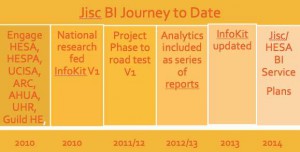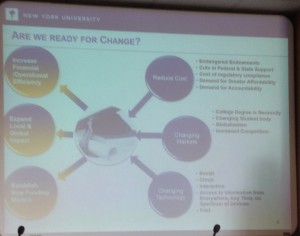I’m very excited about this event. I’m currently working with the UK Higher Education Statistics Association (HESA) and HESPA the Higher Education Strategic Planners Association on a collaborative project. We’re planning on building a National Business Intelligence System for UK Higher Education.
We’re in the planning phase of that when along comes this event. The EUNIS BI Conference. Full program here
So this blog post may be a little selfish; rather than focusing on reporting the entire content I’ll be cherry picking tips and tricks and issues and solutions in BI implementation for HE.

More than half of European countries are represented here today. Three consortia of Universities collaborating on BI related initiatives have sponsored the event. Our top table are; Jean Francois Desnos (Eunis), Jan Madey (MUCI Poland), Ramon Grau (SIGMA Spain), Elsa Cardoso (University Institute of Lisbon Portugal), Michele Menvielli (Cineca Italy)
We’re already hearing about the needs to reduce cost, increase productivity, optimise budget and the opinion that BI solutions are imperative in helping universities achieve these.
The EUNIS task force plans the following activities;
Current state of BI in European HEIs (I know this is based on the OCU Maturity Model as my colleague Steve Bailey of Jisc InfoNet contributed)
Linked In Group, BI Maturity Survey, Case studies and Training sessions on specific topics (I’m interested in this as we intend to put on similar via a virtual national BICC (Business Intelligence Competency Centre)
Here’s a quick summary of Jisc involvement in BI
I’ll blog the Keynote here and other sessions on different pages;
Keynote; Ora Fish – Practical Approach to implementing Business Intelligence in Higher Education (HE)
HE is a late adopter of BI. Reasons why are many and include the breadth of operations not driven by short term objectives, difficulties in KPI identification (though UK HESPA Group have done recent national work on this), lack of analysts and analytical culture (some of these in the UK and across EU but not the case in the US), years of service and loyalty to old ways of operation, academic freedom and complicated governance / over reliance on committees making change slow.
EUNIS Top Technology report (Feb 2014) has reported BI as the number one concern.
Ora outlines the readiness for change agendas with this slide;
Ora reports on the HEDW – it’s an Educause working group of 2100 people on data warehousing. I’m in touch with Educause so one for me to pursue. Looking forward the US is seeing HE BI job advertisements and more interest from BI vendors in the sector. Start with the questions is a message Gartner press. Here’s a great slide on the sorts of questions HEIs want the answers to.
On we got through the fragmented nature of data storage across silos of legacy ERP systems and that thee have not been designed for information retrieval and analysis. A data warehouse i defined as a solution to this, so a collection of data from multiple sources tuned for easy analysis for decision making. Orsa defines BI as the processes, tools, and techs required to turn data into information, information into knowledge and plans to drive effective business activity.
Little gem from Ora – How to measure success of a BI implementation? Look to volume and variety (bit not velocty as that would the the tree Vs of big data) of end users. I like this – in out national BI project we aim to expand the user base of HESA (and non HESA) data to far wider roles than current (tends to be information specialists). Diversity of your BI community is key!
So summing up for the Jisc project, seems as though we’re on the right trajectory;
1. Problems of data locations, accuracy and definitions – sorted by using HESA data sets (our Level 1 service), problematic when expanding to other non HESA data sets (our Level 2 service), very problematic when including institutional data (Level 2 plus)
2. BI as a programme not a project – yep
3. Leadership buy in, governance and sponsorship – at national level – check
4. Funding – tick
5. Technology – to be addressed
6. Change management, training and support – develop from our BICC
I think we also need to add here dashboard prioritisation matrix; wow factor / usefulness for competitive edge (and supporting evidence). We’ll be looking to BICC for that. Seems imprtant that BICC includes the consumers of BI – so the range of roles, the language they use and the questions they hold dear. One for our project there – diversity of role inclusion and effectiveness in prioritisation of dashboard and visualisation features.
Top tips on implementation approaches;
Plan Big, Deliver Small and Fast. Be iterative and agile in development. Focus on business questions to answer
Integrated data warehouse – Kimball Bus Architecture is recommended here
Star Schemas and conformed dimensions
Capture business meta data
Capture business definitions
Testing, Validations and Certification (What, how, when)
Rollout (What, how, when and what training)
Ora presented a few dashboards for specific roles. Wouldn’t it be great if we shared these for Higher Education by a Flikr account? At Jisc we made a start on this here. I’ll add it to the Jisc/HESA BI Project Plan.
Lastly Ora concentrated on Change Management issues. The big one of BI exposing poor data was tackled by procedures to raise awareness of inaccuracies and timescales given for correction. Sounds simple. Bet it isn’t!
Questions here were very much focused on institutional BI implementations. There was one on predictive analytics and Ora described student performance, so what I know as learning analytics, but said nothing much else going forward on predictions for enterprise intelligence. Scenario planning is still prevalent. Master data management also gets a mention.


